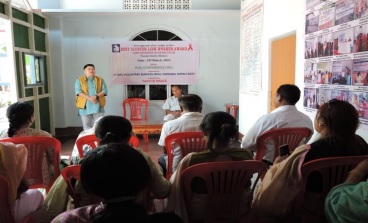Link Worker Scheme Project under MSACS
The link worker scheme project is implemented as HIV/AIDS prevention program under the National AIDS Control Program Phase III. The program is to reach out HIV related services to all typology in the rural areas. It covers the rural High-Risk Groups and Vulnerable Populations with provisions for prevention, testing and treatment services for HIV/AIDS and STI under the National AIDS and STD Control Programme. The NACP phase V (2021-26) envisages continuing and developing the Link Worker Scheme to reduce the new HIV infections. The programme is committed towards ending AIDS as a public health threat by 2030 with a focus on High Risk Groups and Other Vulnerable Populations in rural India.
HIV epidemic in India is concentrated in nature. The HIV prevalence continues to be low with an adult HIV prevalence of 0.22% (95% CI: 0.21–0.24).The prevalence among the HRG population such as Female Sex Workers (FSW), Prison Inmates, Men who have Sex with Men (MSM), Hijra/Transgender (H/TG), People Who Inject Drugs (PWID) is 7-28 times of adult population. Around90% of HIV infections are through the sexual route at national level. Higher prevalence of Hepatitis, especially of Hepatitis C virus among PWIDs, has been noted. HIV prevalence of 1% or more was noted at 44 sentinel surveillance sites. Further, the changing dynamics of solicitation of clients, use of online platforms to find sexual partners, substance use among HRGs is not only observed in urban areas but is also seen in rural areas. The current trends in India reveal that disease is spreading from urban areas to rural areas beyond groups with typically “highrisk” behaviour such as sex workers, STI clinic attendees and long-distance truck drivers. The spread of HIV in rural areas is favoured by widely prevalent sexually transmitted infections (STIs).
OBJECTIVES OF LINK WORKER SCHEME:
- The scheme aims at building a rural community model to address the complex needs of rural HIV prevention, care and support requirements in selected geographies.
- The scheme aims at reaching out to the rural population who are vulnerable and are at risk of HIV/ ADIS in a non-stigmatized enabling environment.
- The scheme aims at improving access to information materials, commodities (condoms, needles/syringes) through collaborating with the nearest TI or government health facilities, testing and treatment services ensuring there is no duplication of services or resources.
- The scheme aims at improving linkage to other social and health benefits provided by other line departments in line with local norms, regulation suitable for vulnerable populations.
SERVICES PROVIDED UNDER LINK WORKER SCHEME
| Target groups | Common services provided | Specific Services |
|---|---|---|
| High Risk Groups |
||
| Female sex Workers Men Who Have sex with Men | Information and counseling regarding risky behaviour and ways of preventing them. Condom negotiation skills. Information accessing services for STIs, accessing testing services. Information and counseling related to safe sex practices. Information regarding availability of Condom (both free and social marketing. Referral and linkages with the nearest ICTC/FICTC and follow up of referred cases. | Provision of condoms |
| People who inject Drugs | Provision of needles and syringes by linking to nearest TI. Collection of used needles and syringes and processing for bio medical waste management through nearest ANM/PHC/TI/ICTC centers. Information on how to prevent abscess. Referral to nearest health centers for over dose management, OST( if available) Provision of condoms. |
|
| Bridge population highly vulnerable | ||
| Truckers (Local) Migrants (All categories) | Information and counseling regarding the risk of unsafe sex. Risk of STI and importance of syndromic case management. Information regarding condom availability. Information regarding importance of testing services to ensure early detection and access to services. | Provision of condoms. Referral and linkages to ICTC and follow up. Family counseling. |
| Spouse of HRGs who also act as commercial partners | Information and counseling regarding safe sex, condom negotiation skills. Referral and linkages with ICTC and ART centers Information and counseling regarding STI/RTI and importance of syndromic management. Information regarding availability of condoms | Provision of condoms Follow up for STI treatment, referral and linkage for syndromic management. |
| Bridge population with low vulnerability |
||
| Regular partner and casual partners of Bridge population | Information regarding condom use as triple protection Importance of RTI/STI, partner management and syndromic management. Information regarding availability of materials, condoms. | Partner counseling and referral for STI checkups, voluntary counseling and testing. Referral and follow up for services of STI/HIV testing and ART. Periodic Health camps in selected out migrant ion villages. |
HRG COVERAGE:
The Link Worker Scheme, Project has a target of 620 HRGs during FY 2024 – 2025 and covered 679 HRGs covered in three different blocks i.e. Thoubal, Lilong and Kakching block. Out of the total 679 HRGs some were newly identified and registered in the project (HRGs that are not in the Situation Need Assessment) by the cluster link workers from their clustered villages.The below table and the chart shows the number of individual clients headcount covered by the link workers. These HRGs were regularly followed up by the Cluster Link Workers and we also come across that some of the HRGs are drop out and some are report death or migrated.During this year 1 HRGs were detected positive
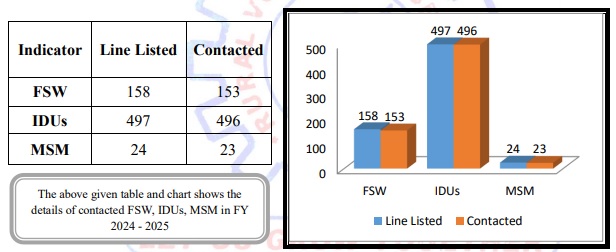
HRGs ICTC TESTING AND STI TESTING:
The below table and the chart shows the number of HRGs tested at ICTCs and STI Clinics in this financial year 2024 – 2025.Out of the total line listed 679 HRGs (i.e. FSW 158, MSM 24 and IDUs 497) 664 HRGs (i.e. FSW 149, MSM 22 and IDUs 493) were counsel and Tested at different ICTC Centers and 552 HRGs (i.e. FSW 127, MSM 20 and IDUs 405) were re-tested. The project also provided screening for syphilis to 433 HRGs during health camps and referral at DSRC (i.e. FSW 113, MSM 17 and IDUs 303).21 FSW and 10 IDUS were diagnose and provided presumptive treatment for STI.
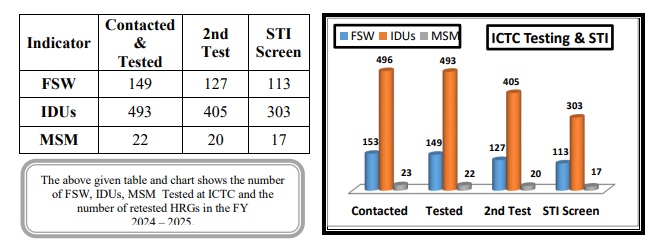
TRUCKER:
Trucker population is also one of the most important typology of the project. Trucker population are commercial drivers who move to the high prevalence districts or towns/cities within or outside the state and have evidence of risk exposure (buying or selling; injecting habits based on the information from the destination intervention). These truckers use live for short duration, thus
having the risk of carrying HIV from one place to another. The below table and the chart shows the total number of Trucker population covered and tested at ICTC and STI Clinics. In this financial year 2024 – 2025out of the total line listed 359 Truckers the project could contact 324 trucker populations and 226 were counsel and tested at ICTC Centers.
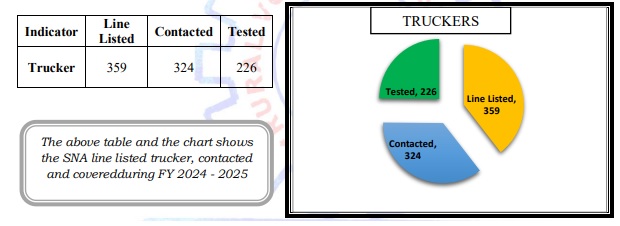
MIGRANT:
Migrant population is also one of the most important typology of the project. Migrant population are men or women who migrate to the high prevalence districts or towns/cities within or outside the state and have evidence of risk exposure (buying or selling; injecting habits based on the information from the destination intervention). These migrants use to circular and of short duration, thus having the risk of carrying HIV from one place to another. During this financial year 2024 – 2025 the project has listed 366migrant populations both male and female; out of the total line listed 366 migrant populations the link workers could contact 302 migrant populations. They were given counseling and information about HIV. 191migrant populations were tested for HIV at the nearest ICTC Centers.1 positive case was detected
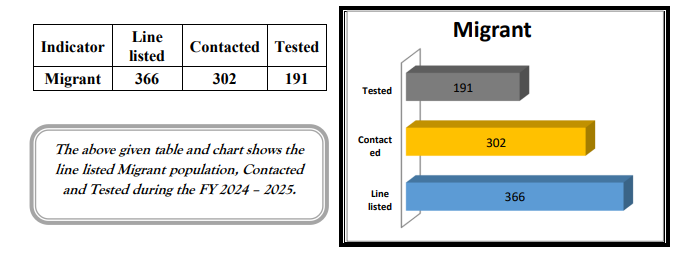
VULNERABLE POPULATION:
Vulnerable populations are those people who use to move to nearby towns for work or business and may come back on the same day or during weekend. It is found that during their stay they meet HRGs or sometimes sell or buy sex during their stay in the town. The vulnerable population includes partners / spouses of migrant/ mobile men and women, partners /spouses of commercial drivers/cleaners, men who have sex with men (not necessarily anal sex), IDUs (not necessarily sharing needles), youth population who have STI or HIV, TB patients, clients of HRGs and ART patients. The below table and the chart shows the number of vulnerable population listed in the line list during this financial year 2024– 2025. The project has listed 1238 vulnerable population; out of the line listed numbers link Workers could contact 1095 vulnerable population from their cluster villages. They were given counseling, information on HIV and condoms. 661 vulnerable populations were referred to ICTC centers for HIV testing.
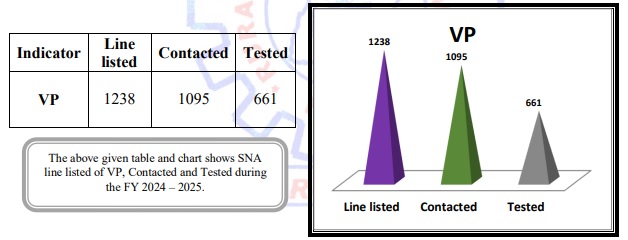
CONDOM DISTRIBUTION:
Condom distribution is one of the most important activities of the Link Worker Scheme Project. The cluster link workers provided condoms through the condom depots and through free distribution in the field level. The link worker also provided information and counsel about the risky behavior and ways to prevent them, condom negotiation skills and safer sex practices. During this financial year 2024 – 2025 the link workers provided 30490 condoms (FSW 3445, MSM 425, IDUs 5395, Migrant 3300, Truckers 3725, PLHIV 205 and vulnerable population 13995) through depots, free distribution and 260 through social marketing condom depots IDUs 36, Truckers 80, migrant 80 and vulnerable population 160.
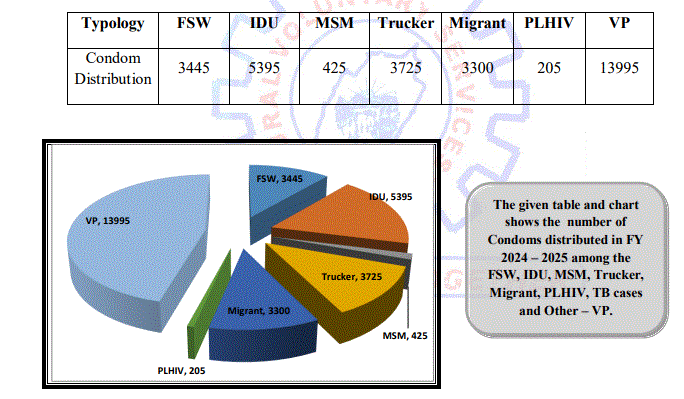
ADVOCACY AND LOCAL BODY MEETING:
Advocacy and local body meeting are the two major components of the project to achieve he objectives and goals. In this program we advocate to the stakeholders of the village for our clients to make them understand the importance of the Link Worker scheme to the community and make easy for the clients to access the services. In this program we invite the PRIs members, Local leaders, Head man of the village, Religious leaders, Meirapaibies, ASHA, AWW and local youth club members etc. in this reporting period 2024-2025 the project has conducted 20 advocacy programs and 40 local body meeting.
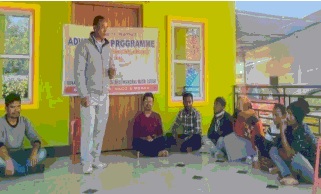
HEALTH CAMPS:
Health camps are specific events organized at Panchayat level especially during festivals when migrants return to their village. This program helps migrant population to get health checkup
as well as undergo HIV counseling and testing. During this health camp doctor, nurse, ICTC counselor, medicines, IEC materials and condoms were provided. The link worker project organized 16 health camps and 24 CBS testing at different village during this financial year 2024 – 2025.
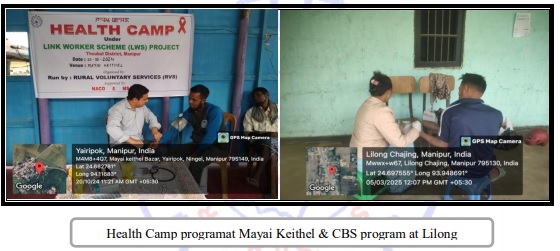
WALL PAINTING:
10 Wall Painting has been conducted in the community level where the vulnerability is very high. It is based on the report found in the SNA conducted by the Link Workers. The wall painting has been painted in bi-lingual. It was painted at community Hall Wall, Waiting shed, Shop etc.
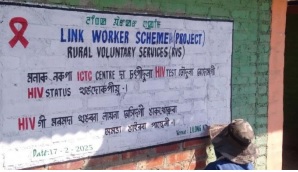
LINK WORKER AWARD:
5 Cluster Link Workers were selected based on their good conduct and punctuality over the last 12 months, excellence performance against the project target and new initiatives and efforts taken by the Cluster Link Worker to strengthen the program or to achieve the project activities.
